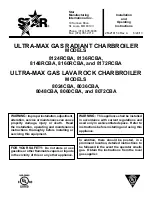
2.4
VENTILATION REQUIREMENTS
Detailled recommendations for air supply
are given in BS5440:2. The following notes
are for general guidance:
– It is not necessary to have a purpose
provided air vent in the room or
compartment in which the appliance is
installed.
2.5
GAS SUPPLY
– The gas installation should be in
accordance with BS6891. The gas
required for the boiler is specified in
section 1.3.
– Ensure that the pipework from the meter
to the appliance is of adequate size.
– The governor at the meter must give a
constant outlet pressure of 20 mbar (8
inwg) for natural gas and 30 - 37 mbar
(12 - 15 inwg) for LPG, when the
appliance is running.
– The gas supply line should be purged.
NOTE: Before purging open all doors
and windows, also extinguish any
cigarettes, pipes, and any other naked
flames.
– The complete installation must be tested
for gas soundness.
2.6
ELECTRICITY SUPPLY
The appliance MUST be earthed. A mains
supply of 230 V - 50 Hz single phase is
required. All external controls and wiring
MUST be suitable for mains voltage.
Wiring should be in 3 core PVC insulated
cable NOT LESS than 0.75 mm
2
(24 x 0.2
mm) to BS6500, Table 16. Wiring external
to the boiler MUST be in accordance with
current l.E.E. Wiring Regulations (BS 7671)
and local regulations.
The supply connection to the flying lead
provided MUST be made to a fused double
pole switch, having a 3 mm (1/8 in) contact
separation in both poles, serving only the
boiler and system controls; the fuse rating
should be 3 amp.
This connection should be readily accessible
and be made adjacent to the boiler (except
in the case of bathroom installations for
domestic boilers where the point of
connection to the mains MUST be outside
of the bathroom).
2.7
EXTERNAL CONTROLS
(Refer to section 2.8.1)
The boiler is intended for use with a 24 V
room thermostat. The connection is made
inside the control box as described in
section 3.9.
2.8
WATER SYSTEMS - GENERAL
– This appliance is designed for connection
to sealed central heating water systems.
– Check that the mains water pressure is
sufficient to produce the required D.H.W.
flow rate, but does not exceed the
maximum D.H.W. pressure (1.3 point).
Where mains pressure exceed 6 bar a
pressure reducing valve must be fitted
in the D.H.W. inlet.
2.8.1
Treatment of water
circulating systems
– All recirculatory systems will be subject
to corrosion unless an appropriate water
treatment is applied. This means that the
efficiency of the system will deteriorate
as corrosion sludge accumulates within
the system, risking damage to pump and
valves, boiler noise and circulation
problems.
– For optimum performance after
installation this boiler and its associated
central heating system must be flushed
in accordance with the guidelines given in
BS 7593 “Treatment of water in
domestic hot water central heating
systems”.
– Sime ltd recommend only the use of
FERNOX products for flushing and water
treatment. This particularly important in
hard water areas.
Failure to flush and add inhibitor to the
system may invalidate the appliance
warranty. Artificially softened water
must not be used to fill the heating
system.
– It is important to check the inhibitor
concentration after installation, system
modification and at every service in
accordance with the manufacturer’s
instructions. (Test kits are available from
inhibitor stockists).
2.9
REQUIREMENTS
FOR SEALED
WATER SYSTEMS
The heating system design should be based
on the following information:
a) The available pump head is given in fig. 5.
b) The burner starts when the C.H. flow
reaches 400÷450 l/h. This safety
condition is ensured by the flow switch.
c) The appliance is equipped with an internal
by-pass that operates with system heads
(H) greater than 3 m. The maximum flow
through the by-pass is about 300 l/h. If
thermostatic radiator valves are to be
installed, at least one radiator should be
without a thermostatic valve (usually the
bathroom radiator).
d) A sealed system must only be filled by a
competent person using one of the
approved methods shown in fig. 7. The
system design should incorporate the
connections appropriate to one of these
methods.
0
200
1600
1400
1200
1000
800
600
400
PORTATA (l/h)
PREV
ALENZA RESIDU
A (mbar)
500
400
100
200
300
30
20-25
Me
tr
opolis DGT
600
30
20-25
By-pass inserito
By-pass escluso
FLOW RATE
(l/sec)
A
V
AIL
ABLE HEAD
(mbar)
Fig. 5
By-pass ON
By-pass OFF
11
ENG
IT
ES
Содержание Metropolis DGT 25 BF
Страница 3: ......
Страница 34: ...34 ENG IT ES NOTES...












































